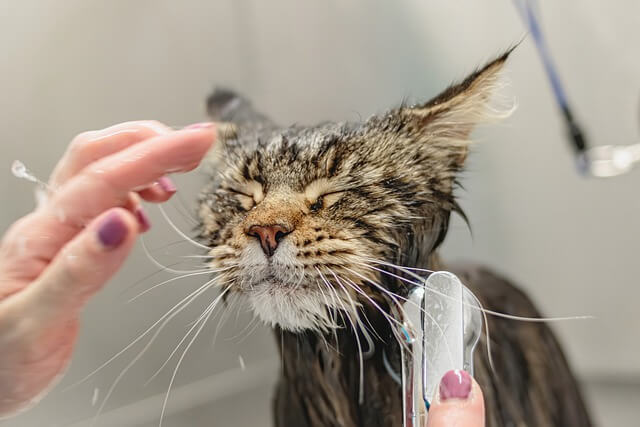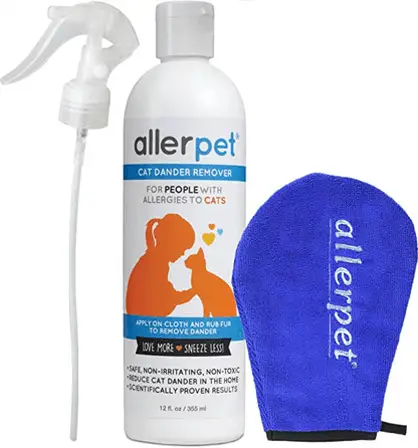5 Tips to Deal With Cat Allergies
05.01.2022.
If you’re like us and you love cats, you probably know how amazing and lovable these animals are. However, 3 out of 10 Americans have cat allergies! Dealing with cat allergies is something many cat owners need to do on a daily basis. If you’re a new cat owner with cat allergies, or you’re thinking of becoming one, you should know how to safely deal with that irritating inconvenience. Here are 5 tips on how to deal with cat allergies.
1. HEPA air filters
One of the things we started using after getting advice from more experienced owners is to use HEPA air filters. There are many different products to choose from, and we personally use Winix 5500-2 Air Purifier with True HEPA. If your budget allows, take two and place one in your bedroom and one in the room your cat mostly stays in. This thing will purify the air in your home. That means the carbon filter will catch allergens in the air and provide some much-needed relief for your nose, eyes, and skin.
2. Vapor steam cleaner
According to 2020 research, vapor steam cleaners will destroy allergens upon contact. Despite our best efforts, some allergens can stay all around our home. One of the most efficient ways to deal with them is by using a vapor steam cleaner. The research proved this is an effective way of getting rid of everything that might be triggering your allergies from things like the sofa, floors, carpets, or anything that has fabric that might hold cat allergens. The PurSteam Steam Mop Cleaner is an affordable and convenient way to make sure your home is allergen-free.
3. Keep your cat clean
Most cat owners will tell you cats hate baths. However, a bath is not the only way you can keep your cat clean. You can also get a microfiber cloth that will help you scoop any allergens from your cat. This is a nice and pretty easy way of dealing with your cat allergies. There is also a product called Allerpet, which will help you remove your cat’s dander and help you control your allergies. Talk to your vet about Allerpet, and ask them if they think it is a good option for you and your cat.
4. Keep a separate cat room
This might be pretty difficult for some cat owners. Still, if you have severe cat allergies and you are a cat owner, it would be pretty wise to keep your cat or cats in a separate room. You can focus your air filters, cleaning, and most allergy controlling efforts on that room. It would be a pretty good idea to wash your bedding at 140-degree at least twice a month. You will keep allergens in one place, and have an easier time dealing with the rest of your home.

5. Antihistamines
Perhaps the best-known way of dealing with any kind of allergy is taking medications. Antihistamines are meds that will counteract histamines in your body. They will essentially block your body’s reaction (or overreaction) to basically harmless allergens. Again, there are many options you can get, like Benadryl, Claritin, or Zyrtec. It would be best to talk to your doctor and see which options would be best for you.
How can I know if I’m allergic to my cat?
There are a few tell-tell signs that allergy sufferers will notice. The most common cat allergens will react with membranes in our eyes and noses. That means we will end up having stuffy noses and inflamed eyes. Another possibility is skin rash. However, skin rashes are usually present in most severe cases. These are the main symptoms allergy sufferers will experience.
Another potential issue is with the respiratory system. Those of us allergic to cats can experience trouble breathing, wheezing, and sneezing. The allergen can easily reach our lungs while we breathe and mix with antibodies which will cause all sorts of issues. This is especially dangerous for people with asthma. They can have a severe attack which is potentially dangerous.
What causes cat allergies?
Most cats produce different allergens. However, the most common ones are present in;
- Dander
- Saliva
- Urine

These common allergens will get transferred to the cat’s coat during grooming. That means that as soon as an allergy sufferer gets in contact with those things, their allergies will act up. Most of us don’t even have to get in contact with a cat to get our allergies triggered. Those allergens can be transferred through the cat’s owner’s clothes.
How dangerous are cat allergies?
In most cases, cat allergies are uncomfortable and irritating. They will cause a stuffy nose, redness, itching, sneezing, and mild eye inflammations. However, those that have severe allergies should really be careful. Allergens produced by cats can cause a severe reaction called anaphylaxis.
What is anaphylaxis?
Anaphylaxis is the most dangerous type of allergic reaction. The person with anaphylaxis will have their body release a lot of chemicals into their bloodstream. That means the reaction will be severe, and the person can go into shock. This state can occur only seconds after being exposed to allergens. The most common symptoms of anaphylaxis are hives, redness, pale skin, blood pressure drop, airway constriction, swollen tongue or throat, dizziness, fainting, nausea, diarrhea, and vomiting.
In conclusion
The best thing you can do if you have severe cat allergies is talking to your doctor about long-term solutions. The advice we provided here is mainly applicable to individuals with mild allergies. Those with severe cat allergies should look for other solutions. You can try immunotherapy, but that will take a long time to take effect. Nevertheless, if you are a cat lover with mild cat allergies, there are ways you can deal with them. That is terrific news for all of us that love cats but have allergies.
World Cat Finder Team









Share